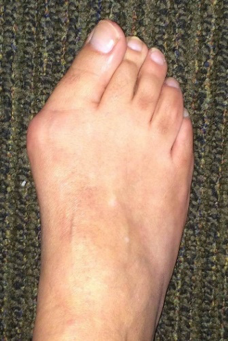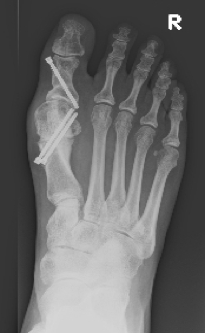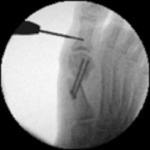What can be achieved with bunion surgery?
Bunion correction surgery (bunionectomy) relieves pain by restoring normal alignment of the first toe joint. The procedure consists of the realignment of bones or soft tissue and/or joint fusions and the before and after results may be quite profound.




Bunionectomy techniques
It’s essential to treat the cause of bunions, not just the symptoms. It’s necessary to:
- Bring the metatarsal (long bone in the foot) towards the second toe. The first metatarsal is divided into two parts. The lower part contains the head, which is brought towards the second metatarsal, and the two parts are fixed using two tiny screws. The screws are fixed in the bone and you will not be able to feel these after the procedure. These may be removed after six months if they cause any problems.
- Align the big toe along the metatarsal. This is brought about by straightening the proximal phalanx (the toe bone closest to the leg) and re-aligning the great toe to the level of the first toe joint. This is held by a special, tiny staple. Again, this cannot be felt and rarely causes symptoms.
During the Corrective Procedure
What happens after surgery?
After surgery, a specially designed shoe is worn to enable weight bearing. The shoe minimises the weight exerted on your forefoot and redirects it to your heel. You can expect this for up to eight weeks after surgery.
Crutches may also be required if the anaesthetist performs a regional block.
We recommend the Darco Orthowedge Shoe (available from our Albury rooms or from the East Sydney Private Hospital).
Some pain and swelling can be expected following surgery but can be managed with oral pain medication and elevating your foot above heart level. Surgical dressings must be kept dry and intact until your first post-operative appointment, 1-2 weeks after surgery.
Walking must be kept to a minimum for the first week following the procedure and then increased gradually. You should continue to elevate your foot from time to time.
You’ll need to schedule post-operative appointments, 2, 4 and 8 weeks after surgery, and then at 3, 6 and 12 months. X-rays may be required at each visit to evaluate bone healing and the position of the big toe and to determine the level of weight-bearing that you can tolerate. Most importantly, you should not wear shoes that create extra stress on the joint.
Bunion Taping
Potential Complications
As with any surgery there are complications that may develop. These include risks associated with anaesthesia, infection, damage to nerves and blood vessels, and bleeding or blood clots. There may also be potential complications with the bone failing to heal or disruption of the blood supply to the cut bone.
Surgically corrected bunions have the potential to recur, even when the procedure is performed correctly. Patients can help prevent this by carefully following post-operative instructions. Rehabilitation Movement, re-training and exercise are key to recovery. Is it better to have my bunion fixed now, or should I wait? If bunion pain interferes with your daily activities or shoe modifications don’t help, it’s time to discuss surgical options.







